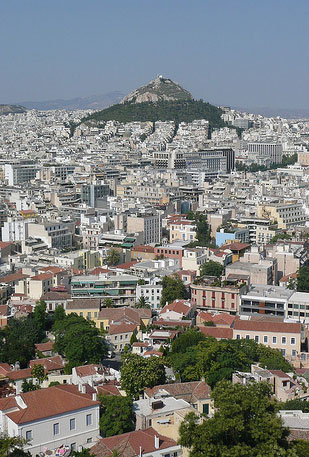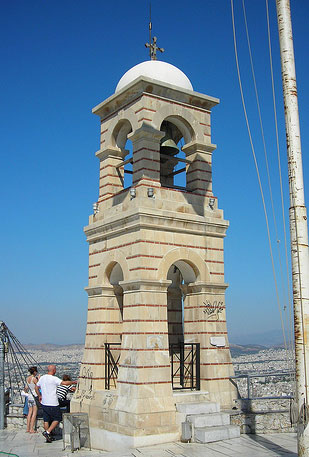

Athens Lycabettus Hill
The flight of steps from the funicular (with spectacular view of the Acropolis and surrounding hills) brings one to the highest point in central Athens, at 277.3 metres above sea level. It is the southernmost spur of the small chain of mountains in the Attica basin called Tourkovounia (Turkish Mountains). On a clear day (alas, unusual for most of the year) one can see most of central Attica, the Saronic Gulf and its northern islands and the northeastern Peloponnesos.
At the summit is a small, double chapel, one half dedicated to Aghios Georghios (St. George) and the other to Profitis Elias (Prophet Elias) and Aghios Konstantinos (St. Constantine). In the mid-30s a chapel to Aghios Georghios Kavalaris (the Rider) was constructed where a chapel for Profitis Elias once stood in the Frankish period. This new chapel was enlarged in the late 19th century to include a chapel to Profitis Elias and Aghios Konstantinos. Queen Olga took the chapel under her protection and made a gift of a bell, which was hung in a bell tower donated by Nikolaos Thon, a leading court official. Just below the summit on the west side are two cannons which fire salutes on national holidays and special occasions. After the church service on the night of Easter Saturday (Megalo Savvato), when the Resurrection of Christ is proclaimed by the lighting of candles around midnight, those in attendance at the chapels exit with their burning candles to walk down the various paths to their homes. The view of these streams of flickering lights descending in the darkness is very moving!
The hill may have been named after the wolves (lykoi) which probably roamed here in ancient times. More likely it is a pre-Hellenic place name. In antiquity, goddess Athena was believed to have dropped this rock, which she was carrying from Mt Penteli to augment the Acropolis, when she learnt that Aglauros (or Pandrosos and Herse) had peeked into the chest containing Erechtheus, against her strict orders. There is only one direct reference to this hill in the Classical and Hellenistic periods, in Aristophanes' comedy Nefeles (Clouds). Even though on this hill's southwestern slopes were the springs which were the source of Eridanos river according to Strabo, this was way beyond the limits of the built up area of ancient Athens. Except for the reservoir and the aqueduct of Hadrian, there are no ancient remains around here, although some scholars argue that there may have been a shrine to Zeus Akraios on the summit of Lycabettus. More likely this was on a nearby lower hill to the north called in ancient times Anchesmos (modern Lophos tou Strephi). At some point during the Byzantine period the barren slopes of the hill were planted with olive trees. By the early 19th century as early paintings, drawings and later photographs clearly show, it was barren again. In 1882 the Philodasiki Etaireia ("Society for the Protection of Forests") planted the slopes with the present pine and cypress trees. This effort was completed by 1915. Encroachment by apartment buildings on its southwestern lower slopes in the 1960s and 1970s unfortunately reduced the woodland. On the north slope of the hill a quarry was opened after 1834 to provide building stone for the new capital. In this old quarry between the main summit and its eastern spur, Schisti Petra (Split Stone), a simple open-air theater was built in 1964/5, the work of Takis Zenetos (1926-1977). Here all manner of concerts, plays and other types of performances are put on regularly in the evening, as part of the Athens Summer Festival from June through September. This is a great and easy way to escape some of the heat and congestion of the city as well as and enjoy some contemporary Greek and international popular culture. During the day the paths and roadways which criss-cross the hill are delightful places to walk or jog.
